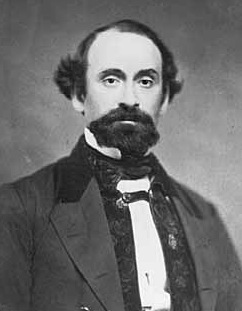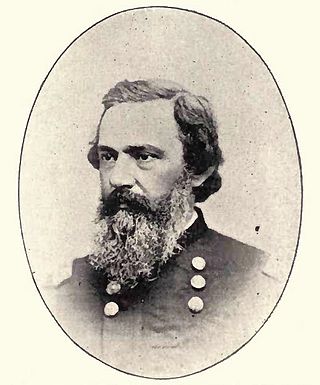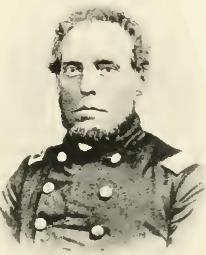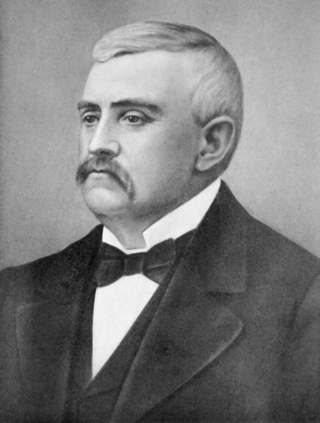
The Battle of Prairie Grove was a battle of the American Civil War fought on December 7, 1862. While tactically indecisive, the battle secured the Union control of northwestern Arkansas.

John Alexander McClernand was an American lawyer, politician, and a Union Army general in the American Civil War. He was a prominent Democratic politician in Illinois and a member of the United States House of Representatives before the war. McClernand was firmly dedicated to the principles of Jacksonian democracy and supported the Compromise of 1850.

The Battle of Big Black River Bridge was fought on May 17, 1863, as part of the Vicksburg Campaign of the American Civil War. During the war, the city of Vicksburg, Mississippi, was a key point on the Mississippi River. On April 30, 1863, a Union army commanded by Major General Ulysses S. Grant began crossing onto the east side of the Mississippi River as part of a campaign against Vicksburg. After engaging and defeating Confederate forces in several intermediate battles, Grant's army defeated Lieutenant General John C. Pemberton's Confederates at the decisive Battle of Champion Hill on May 16. During the retreat from Champion Hill battlefield, one division of Pemberton's army, commanded by Major General William W. Loring, was cut off from Pemberton's main body. Pemberton, retreating westwards towards Vicksburg, did not know the location of Loring's division, and he held a bridgehead on the east side of the Big Black River to cover Loring's anticipated withdrawal across the river on the morning of May 17.

Alfred Washington Ellet was a brigadier general in the Union Army who commanded the United States Ram Fleet and the Mississippi Marine Brigade during the American Civil War.

Amasa Cobb was an American politician and judge. He was the 6th and 9th Chief Justice of the Nebraska Supreme Court and the 5th Mayor of Lincoln, Nebraska. Earlier in his life, he was a United States Congressman from Wisconsin for 8 years and served as the 13th Speaker of the Wisconsin State Assembly. He also served as a Union Army officer during the American Civil War.

William Vandever was a United States representative from Iowa and later from California, and a general in the Union Army during the American Civil War.

The Miller–Davis Law Buildings, known commonly as the Miller Davis Building, are located on Main and Front Street in the McLean County, Illinois city of Bloomington. The law offices served future Supreme Court Justice David Davis and future Illinois State Senator Asahel Gridley. The buildings became a gathering place for local lawyers such as Abraham Lincoln and Stephen A. Douglas.
The 95th Regiment Illinois Volunteer Infantry was an infantry regiment that served in the Union Army during the American Civil War.

William Milo Stone was the sixth Governor of Iowa (1864–68).

William Plummer Benton was an American lawyer and soldier who served in both the Mexican–American War and the American Civil War, where he would rise to the rank of brigadier general and, in 1866, after his service had ended, would be awarded the brevet grade of major general.

John Benjamin Sanborn was a lawyer, politician, and soldier from the state of New Hampshire who served as a general in the Union Army during the American Civil War. He was also a key member of the reconstruction era Congressional-appointed Indian Peace Commission, which negotiated and signed several important treaties with native American tribes.

John Eugene Smith (1816-1897) was a Swiss immigrant to the United States, who served as a Union general during the American Civil War.

John Dunlap Stevenson was an American attorney, politician, and soldier in the U.S. Army in two wars. He was a brigadier general of volunteers during the American Civil War. In 1866 he was nominated and confirmed for appointment as brevet major general of volunteers.

William McEntyre Dye was a soldier from the United States who served in military capacities around the world. He became a brevet brigadier general in the Union Army during the American Civil War, a colonel in the Egyptian army and military adviser to the King of Korea.

Michael Kelly Lawler was a volunteer militia soldier in the Black Hawk War 1831–1832, an officer in the United States Army in both the Mexican–American War and the American Civil War. In the latter conflict, as a brigadier general he commanded a brigade of infantry in the Western Theater and served in several battles.

Sylvester Gardner Hill (1820-1864) was a colonel in the Union Army during the American Civil War. He served as a brigade commander during the Red River Campaign and Battle of Nashville where he was killed in action. He received a posthumous appointment as a brevet brigadier general.

Lyman Munson Ward was an American farmer, Republican politician, and Union Army colonel in the American Civil War. He served four years in the Michigan House of Representatives, and received an honorary brevet to brigadier general after his service in the war.

Friend Smith Rutherford was an American military officer who was colonel and posthumously appointed brigadier general in the Union Army during the American Civil War. He commanded the 97th Illinois Infantry Regiment during the Vicksburg campaign. On June 18, 1864, President Abraham Lincoln nominated Rutherford for appointment to the grade of brigadier general of volunteers and the United States Senate confirmed the appointment on June 28, 1864. Rutherford's appointment was dated June 27, 1864, and it was to rank from June 28, 1864. His appointment was made and commission issued without knowledge of his death on June 20, 1864. Since Rutherford had died, the confirmation technically could not be given and the commission could not become effective. Nonetheless, several sources list Rutherford as a Union Army general, although historian Ezra Warner does not.

Battery E, 1st Missouri Light Artillery Regiment was an artillery battery unit from Missouri that served in the Union Army during the American Civil War. The 1st Missouri Light Artillery Regiment formed on 1 September 1861. The battery participated in Frémont's expedition to Springfield in October 1861. This was followed by actions at Prairie Grove and Van Buren in December 1862. The following year, the battery fought at Cape Girardeau, Chalk Bluff, Vicksburg, the Expedition to Morganza, Brownsville, and Fort Esperanza. After performing garrison duty at Brownsville, Texas, the unit was mustered out in June 1864. For a few months at the end of 1864, a Pennsylvania battery took the name of this unit.

The 3rd United States Colored Cavalry was a regiment in the United States Army organized as one of the units of the United States Colored Troops during the American Civil War. The regiment was originally formed in October 1863 at Vicksburg, Mississippi as the 1st Mississippi Cavalry Regiment. The unit soon began taking part in expeditions near Vicksburg. In February–March 1864, the regiment saw action at Yazoo City. After being renamed the 3rd U.S. Colored Cavalry in March 1864, the regiment continued to participate in raids, including the Yazoo City expedition in May. In December 1864, the unit took part in a successful raid led by Benjamin Grierson during which the Battle of Egypt Station and other actions were fought. The regiment operated near Memphis, Tennessee, until April 1865, after which it returned to Vicksburg for occupation duties. The soldiers were mustered out of federal service in January 1866.


















